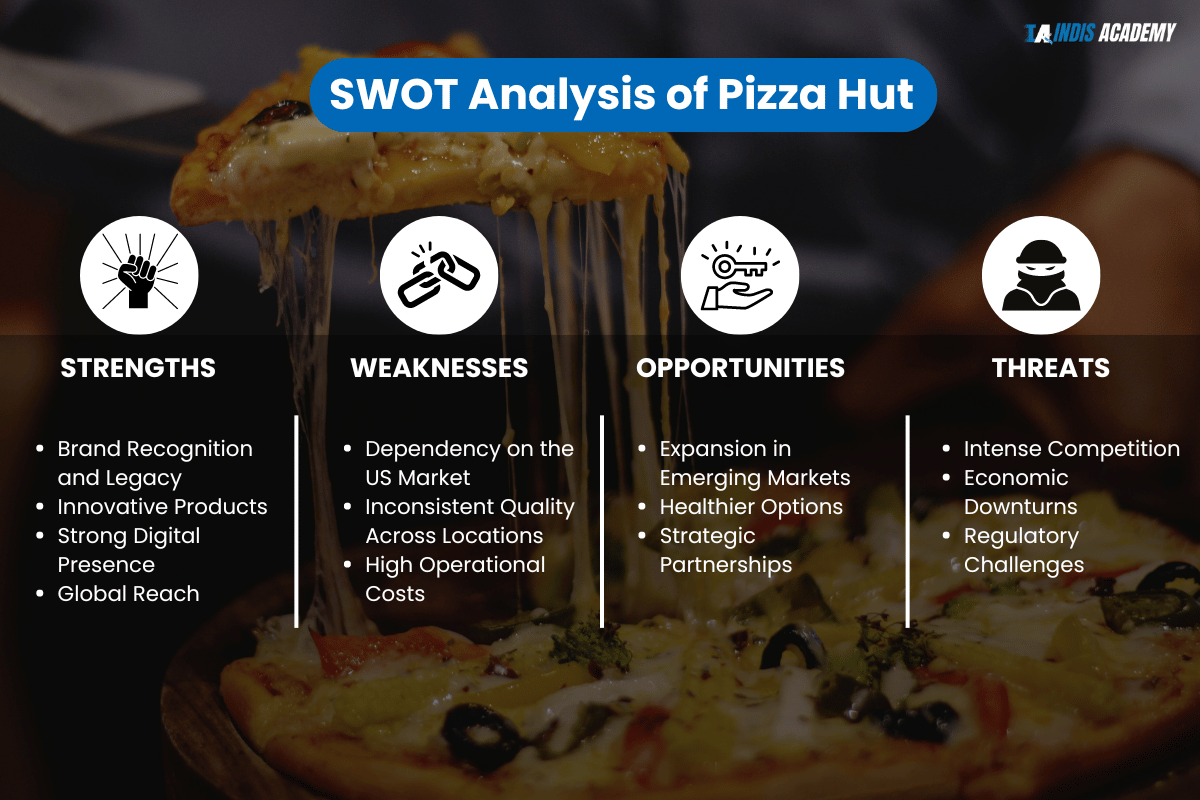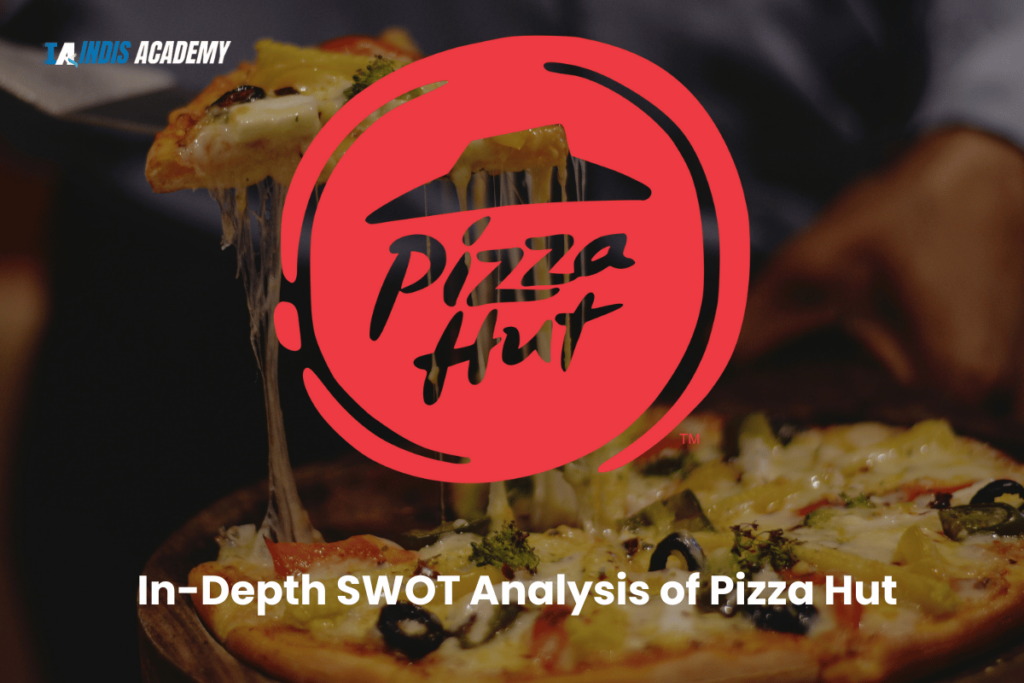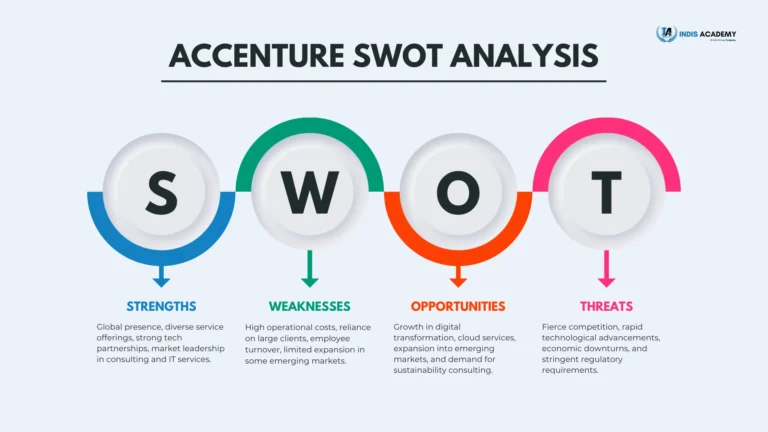In the upcoming article, we’ll conduct a comprehensive SWOT analysis of Pizza Hut, delving into its strengths, weaknesses, opportunities, and threats.
This analysis aims to shed light on how Pizza Hut, a leader in the global pizza market, maintains its competitive edge and navigates the challenges it faces. We’ll explore the company’s robust global presence and innovative marketing strategies that cater to diverse consumer tastes as major strengths.
Conversely, we’ll address the challenges of fierce competition and changing health trends that pose potential risks. Additionally, the article will discuss emerging opportunities such as digital ordering platforms and strategic expansion into new markets. Lastly, we’ll analyze threats including fluctuating food prices and regulatory changes.
This detailed examination will provide valuable insights for business strategists, marketers, and industry analysts looking to understand the dynamics of the fast-food industry.
In-Depth SWOT Analysis of Pizza Hut
About Pizza Hut:
Pizza Hut, a subsidiary of Yum! Brands, is one of the world’s largest pizza chains, with over 18,000 restaurants across more than 100 countries. Founded in 1958 in Wichita, Kansas, it pioneered the concept of franchise-based restaurant chains in the pizza industry.
Pizza Hut is renowned for its wide variety of pizzas, pastas, and side dishes. The brand has adapted to changing consumer preferences by incorporating a range of healthier options and embracing digital technology for improved customer service, such as mobile ordering and delivery tracking. This adaptation has helped maintain its relevance and popularity in a competitive fast-food market.
Pizza Hut Quick Overview:
| Founding Date | 1958 |
| Founders | Dan and Frank Carney |
| Parent Company | Yum! Brands |
| Industry | Restaurants; Fast Food |
| Total Valuation | Not publicly specified; as part of Yum! Brands, it is part of a larger valuation |
| Number of Locations | Over 18,000 worldwide |
| Headquarters | Plano, Texas, USA |
| Number of Employees | Not publicly specified; Yum! Brands employs over 34,000 people globally |
| Website | www.pizzahut.com |
Pizza Hut Products & Competitors:
Pizza Hut has established itself as a prominent player in the global fast food industry, offering a diverse range of products that cater to various tastes and preferences. The company’s product portfolio primarily includes a wide variety of pizzas, which remain the core of its menu. These range from classic choices like the Pepperoni Lover’s Pizza to specialty options such as the Super Supreme, which features a mix of meats and vegetables. Besides pizzas, Pizza Hut also offers pasta dishes, wings, garlic bread, and desserts, including their famous Hershey’s chocolate chip cookie and cinnamon sticks.
The innovation in their menu extends to offering products tailored to local tastes in international markets. For instance, in India, Pizza Hut serves the Tandoori Paneer Pizza, while in Japan, customers can enjoy squid and Mayo Jaga (mayonnaise and potato) pizzas, demonstrating the brand’s flexibility in menu innovation to suit regional palates. Here below some of popular products of Pizza hut are given:
- Pizza
- Pasta
- Wings
- Flavoured Bread
- Breadsticks and Cheesesticks
- Cold and Hot Beverages
Pizza Hut Competitors:
Pizza Hut faces stiff competition in the fast-food pizza market, both from large international chains and local pizzerias. Here’s a look at some of its primary competitors:
| Competitor | Description |
|---|---|
| Domino’s | Known for its delivery service, Domino’s is Pizza Hut’s largest global competitor, offering a similar range of pizza and side dishes. |
| Papa John’s | This chain is recognized for its commitment to ‘better ingredients, better pizza’ and is a significant competitor in the US and other markets. |
| Little Caesars | Famous for its “Hot-N-Ready” low-price pizza model, Little Caesars competes primarily on price and convenience. |
| Local Pizzerias | Numerous local pizzerias also provide stiff competition, often differentiating themselves with artisanal pizzas and local ingredients. |
The competitive landscape in which Pizza Hut operates is intense, with rivals consistently enhancing their product offerings and delivery services. Pizza Hut’s continuous innovation and adaptation to local tastes are crucial in maintaining its competitive edge in this dynamic market.
SWOT analysis of Pizza Hut

Pizza Hut, established in 1958 by brothers Dan and Frank Carney, is one of the cornerstone brands in the global pizza market. Owned by Yum! Brands, it operates over 18,000 outlets in more than 100 countries. A SWOT analysis—examining the Strengths, Weaknesses, Opportunities, and Threats—provides insights into how Pizza Hut maintains its market position and identifies areas for strategic development.
Strengths
- Brand Recognition and Legacy: Pizza Hut’s extensive history and global presence have made it a household name. This recognition translates into a robust customer base and consistent traffic across its many locations.
- Innovative Products: Known for introducing a variety of pizzas, including stuffed crust and pan pizza, Pizza Hut regularly updates its menu, catering to evolving tastes and dietary preferences, which helps in retaining interest and expanding its customer base.
- Strong Digital Presence: Pizza Hut has invested heavily in digital innovation, developing a streamlined online ordering system, a user-friendly app, and implementing AI to improve customer service. These tech advancements enhance customer experience and operational efficiency.
- Global Reach: With outlets in over 100 countries, Pizza Hut’s international market penetration is a significant asset. This global footprint diversifies its revenue streams and reduces market-specific risks.
Weaknesses
- Dependency on the US Market: Despite its international presence, Pizza Hut still relies heavily on its American market. Market saturation and intense competition in the US can limit growth and put pressure on the brand to continually innovate.
- Inconsistent Quality Across Locations: With thousands of franchises around the world, maintaining consistent quality and service can be challenging. Variability in customer experience can affect brand reputation and customer loyalty.
- High Operational Costs: The costs associated with updating technology and interiors to enhance customer experience are substantial. These investments, while necessary for competitiveness, impact profitability.
Opportunities
- Expansion in Emerging Markets: Developing regions present opportunities for expansion, particularly in Asia and Africa, where the demand for Western fast food is growing. Establishing more outlets in these regions could drive significant growth.
- Healthier Options: As health consciousness increases, there is an opportunity for Pizza Hut to expand its menu to include healthier, lower-calorie options and alternatives for dietary restrictions, attracting a broader audience.
- Strategic Partnerships: Collaborating with food delivery services or entering co-branding ventures, as seen with other Yum! Brands entities, could increase reach and operational efficiencies.
Threats
- Intense Competition: The fast-food industry is extremely competitive, with local and international brands continuously enhancing their offerings. Competitors like Domino’s, with its superior delivery logistics, pose a significant threat.
- Economic Downturns: Economic instability, such as that caused by the COVID-19 pandemic, can lead to decreased consumer spending on dining out, affecting sales.
- Regulatory Challenges: Food industry regulations, especially regarding nutritional content and health guidelines, can impact menu development and operational costs.
Conclusion
The SWOT analysis of Pizza Hut highlights a brand with significant strengths and promising opportunities that can be leveraged to overcome its weaknesses and mitigate external threats. Pizza Hut’s longstanding reputation, innovative approach to menu offerings, and strong digital enhancements position it as a leader in the global pizza market.
However, challenges such as its dependency on the US market, inconsistency in service and product quality across franchises, and high operational costs need strategic addressing to maintain its competitive advantage.
Looking ahead, Pizza Hut can capitalize on growth opportunities by expanding into emerging markets where the demand for western-style fast food is increasing. Additionally, adapting its menu to include healthier options could attract a wider demographic, particularly health-conscious consumers.
Strategic partnerships and alliances could also drive efficiencies and broaden its market reach. By focusing on these strategies, Pizza Hut can navigate through competitive pressures and economic fluctuations, ensuring its continued success and dominance in the fast-food industry. This careful balance of leveraging strengths and opportunities against weaknesses and threats is key to sustaining its market leadership.











